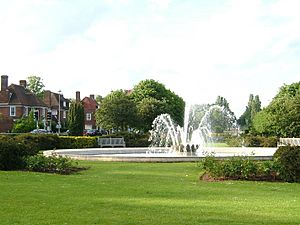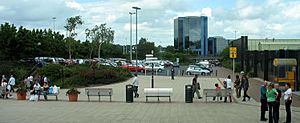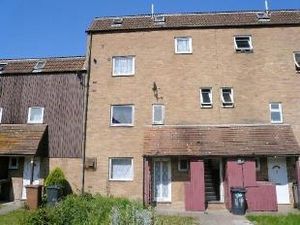New towns in the United Kingdom facts for kids
The new towns in the United Kingdom were special towns planned and built after World War II. Their main purpose was to give people new homes. Many homes had been bombed, or people lived in crowded, old areas. These new towns helped move people to better places.
Each new town was managed by a special group called a development corporation. These towns were built in three main periods, or "waves." Later, some existing towns were also greatly expanded. This helped house people from very busy cities.
Contents
How They Started

Garden Cities: A New Idea
The idea of a "garden city" came from a man named Ebenezer Howard in 1898. He wrote a book about it. He wanted to create places that were better than the dirty, crowded cities in Britain.
He was inspired by villages like Port Sunlight and Bournville. These places offered a much better quality of life. Garden cities were meant to be a mix of town and country. They would have fresh air and green spaces.
Only two true garden cities were built:
- Letchworth, in Hertfordshire, in 1903.
- Welwyn Garden City, also in Hertfordshire, in 1920.
The ideas from these garden cities were very important. They influenced how the new towns were planned after the war. These ideas included:
- People working together in the community.
- Well-designed homes.
- Easy access to shops and fun places.
- Good transport systems.
Overspill Estates: Moving People Out
An "overspill estate" was a housing area built to house extra people from big cities. This happened because cities grew, and also to move people from old, rundown areas. It was often part of clearing slums.
These estates were built on the edges of most large British towns. New towns were another way to solve this problem, especially outside London. The goal was to bring more jobs to smaller communities. It also helped reduce crowding in major cities.
Here are some examples of these large housing areas:
- London County Council built many housing areas outside London. Becontree in Dagenham was the biggest. It was built in the 1920s and 1930s.
- Seacroft in Leeds was planned as a "satellite town" within the city. Most homes were built after World War II.
- Wythenshawe was built near Manchester. It housed families from crowded city slums. Other Manchester overspill estates include Hattersley and Gamesley.
- In Glasgow, areas like Castlemilk and Drumchapel were built.
- Castle Vale was built in Birmingham in the 1960s.
List of New Towns
England
First Wave: After the War
The first group of new towns helped with housing shortages after World War II. They were built outside London's green belt. Two towns in County Durham were also chosen. These towns were created under the New Towns Act 1946.
Some of these first new towns include:
- Stevenage, Hertfordshire (1946)
- Crawley, Sussex (1947)
- Hemel Hempstead, Hertfordshire (1947)
- Harlow, Essex (1947)
- Newton Aycliffe, County Durham (1947)
- Peterlee, County Durham (1948)
- Welwyn Garden City and Hatfield, Hertfordshire (1948)
- Basildon, Essex (1949)
- Bracknell, Berkshire (1949)
- Corby, Northamptonshire (1950)
Second Wave: More Homes Needed

The second group of new towns (1961–1964) also helped with housing shortages.
- Redditch and Telford (originally Dawley New Town) were built near Birmingham. They helped house people from Birmingham and Wolverhampton.
- Runcorn and Skelmersdale were built near Merseyside. They helped house people from Liverpool.
Some towns from this wave are:
- Skelmersdale, Lancashire (1961)
- Dawley New Town, Shropshire (1963)
- Redditch, Worcestershire (1964)
- Runcorn, Cheshire (1964)
- Washington, Tyne and Wear (1964)
Third Wave: Bigger and Further North

The third group of new towns (1967–1970) allowed for even more growth. They were often further north than the earlier London new towns.
- Dawley New Town was renamed Telford. It became much larger to house people from Birmingham and nearby towns.
- Milton Keynes was the biggest of these. It was planned to have 250,000 people. It aimed to be the first "new city."
- The existing town of Northampton was expanded.
- The city of Peterborough was also made a new town. It helped house people from London.
Key towns from this wave include:
- Milton Keynes, Buckinghamshire (1967)
- Peterborough, Cambridgeshire (1967)
- Northampton, Northamptonshire (1968)
- Warrington, Cheshire (1968)
- Telford, Shropshire (1968)
- Central Lancashire New Town, Lancashire (1970). This covered towns like Preston and Chorley. It was meant to join them into one city, but this plan didn't work out.
Yate and South Woodham Ferrers
Yate in Gloucestershire and South Woodham Ferrers in Essex grew a lot between the 1950s and 1970s. They were like new towns, and Yate even called itself one. However, they were not officially created under the New Town Acts.
Wales
Wales also had new towns:
- Cwmbran, Torfaen (1949)
- Newtown, Powys (1967)
Scotland
Scotland had six new towns between 1947 and 1973. Most of these helped house people from Glasgow.
- East Kilbride (1947)
- Glenrothes (1948)
- Cumbernauld (1955)
- Livingston (1962)
- Irvine (1966)
- Stonehouse (1973). This town was later cancelled in 1976.
Other Major Developments in Scotland
Many other large housing areas have been built or are being built in Scotland. These include:
- Blindwells in East Lothian.
- Chapelton of Elsick.
- Dalgety Bay in Fife.
- Erskine and Inchinnan in Renfrewshire.
- Ravenscraig in North Lanarkshire.
- Tornagrain near Inverness.
- Tweedbank in the Scottish Borders.
Future Developments in Scotland
New settlements are also planned for the future, such as Forestmill and Owenstown.
Northern Ireland
The New Towns Act (Northern Ireland) 1965 allowed new towns to be created there. A special group was appointed to manage them.
Other 'Overspill' Developments
At the same time new towns were being built, other towns were also expanded. Local councils led these projects. They were called 'overspills' for larger cities. However, they were not officially named new towns.
Some examples include:
- Cramlington, Northumberland (for Newcastle)
- Daventry, Northamptonshire (for Birmingham)
- Hattersley, Tameside (for Manchester)
- Kirkby, Merseyside (for Liverpool)
- Tamworth, Staffordshire (for Birmingham)
- Winsford, Cheshire (for Liverpool & Manchester)
Newer Town Expansion Schemes
No new towns have been officially designated under the New Towns Act since the 1970s. However, many new large developments have been built.
These include:
- Ingleby Barwick, North Yorkshire
- Bradley Stoke, Gloucestershire
- Chafford Hundred, Essex
- Cambourne, Cambridgeshire
- Ebbsfleet, Kent
- Kings Hill, Kent
- Wixams, Bedfordshire
- Sherford, Devon
- Northstowe, Cambridgeshire
- Cranbrook, Devon
- Nansledan, Cornwall
- Welborne, Hampshire
Poundbury is a special new town in Dorchester. It's built on land owned by the Duchy of Cornwall. It follows the ideas of (then) Prince Charles. He believed in different ways of planning towns.
Euxton has grown a lot with the Buckshaw Village development. This is a very large project on old industrial land. It's designed to be an eco-village.
Future Developments
In 2007, Gordon Brown announced plans for 10 new "eco-towns." These towns would help with the need for affordable homes. They would be "carbon neutral." This means they would not add to carbon pollution. They would use local, clean energy.
In 2014, a business group called the CBI asked for 10 new towns and garden cities to be built. This would help solve the country's housing shortage.
The government has also set out plans for "garden villages" and "garden towns." These focus on green spaces and wildlife-friendly areas. Didcot, Oxfordshire, was one of the first to become a garden town in 2015.
How New Towns Were Paid For
For many years, new towns were funded in a special way.
- An area of countryside was chosen for a new town.
- The government bought the land from owners at farming prices.
- The government borrowed money to build homes, shops, and things like sewers and schools.
- Later, they sold the shops and some homes at higher prices. This helped pay back the debt.
This system faced problems in the 1970s. Rising prices made it more expensive to borrow money. Over time, the groups that built the towns were closed down. Their properties were given to local councils or other organizations.
What Happened Next
In 2002, a special committee looked at how well the new towns had worked. They found that:
- Many new towns had been good for the economy.
- But many were now facing big problems. Their design was not right for the 21st Century.
- Their roads and sewers were getting old. Many towns had social and money problems.
- The way they were designed meant people often needed cars to get around. This is not seen as sustainable today.
Some people who lived in new towns felt a lack of community. This feeling was sometimes called "new town blues."

